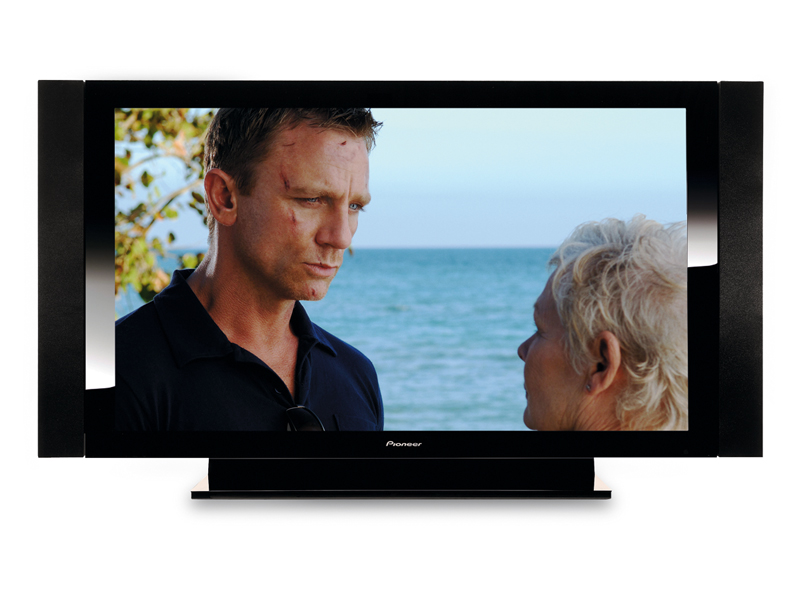TechRadar Verdict
The greatest 50in TV pictures ever are here, if you can afford them
Pros
- +
Magnificent pictures
- +
Stunning to look at
- +
Wealth of features
- +
Beautifully made
Cons
- -
Expensive
Why you can trust TechRadar
As Greavsie said to Saint, "it's a funny old game". Pioneer's epic Kuro range of plasma TVs are arguably the best in the business, but the manufacturer has recently confessed to experiencing sluggish sales, and is switching to LCD. The reason for this change of direction can be concisely summarised – price.
The Kuro range of plasmas rank among the plasma cream, but they are also the most likely to give your bank account a kicking.
Premium plasma performance often goes hand in glove with a premium price tag, and as such costs too much for your average punter to contemplate, slobberingly fantastic as their pictures are. Enter the PDP-LX508D, stage left...
Problem plasma
This superb 50-incher is a prime example of the 'Pioneer problem'. The PDP-LX508D is a high-performance bigscreen plasma TV with a Full HD resolution. The asking price is a whopping £3,300. And that price doesn't generally include speakers or a desktop stand, either.
Compare this with the likes of Panasonic's 50in Full HD 50PZ70 – doing the rounds for about £1,200 from various online retailers – it's clear that the PDP-LX508D has one hell of a mountain to climb to justify that price hike.
The PDP-LX508D begins by seducing us with its sexy looks: it's every inch the premium model in its ultra-minimalist, slender, glass-coated black bezel. All the connections you could desire are here too, including a USB port, an optical digital audio output, a PC port, a subwoofer line out, and – naturally – three v1.3 HDMIs.
Sign up for breaking news, reviews, opinion, top tech deals, and more.
These HDMIs can handle both the Deep Colour image format now found on a couple of HD camcorders, and 1080p/24 feeds from Blu-ray players.
Kuro dominates
Unquestionably, the most important feature here is the TV's Kuro technology, which produces genuinely revolutionary pictures, especially when it comes to black levels.
These bends-inducing black levels are generated by a combination of a new pixel structure designed to reduce light and colour bleed; a new Crystal Emissive Layer built into the screen to enhance the screen's brightness, contrast and response times; plasma cells divided by unusually high walls, so that light and colour can't seep between them; and image processing designed to work completely differently for dark and light footage. In short, some killer tech that'll cost you a hefty admission fee.
Another significant trick of the LX508D is the 72Hz mode you can call in when watching 1080p/24fps footage from a Blu-ray player, which is less likely to introduce stuttering and artefacting.
Our experience with previous Pioneer KURO plasmas means we know the PDP-LX508D is going to be a cracker before we even switch it on. A more interesting question to ask is whether it's sufficiently better than Pioneer's 508XD – the comparatively-sized, HD Ready sister screen – to justify costing well over £1,000 more. How much does the PDP-LX508D Full HD resolution improve the picture quality?
Vital signs
Improvements can be seen in vital areas. High definition sources, such as our Blu-ray of Casino Royale, look a little bit crisper on this Full HD screen. Particularly detailed shots look fantastically intense.
Colours also look a touch more subtle during the movie's richly saturated Bahamas sequence, presumably as the screen's extra pixel density helps the TV produce smoother colour blends. This in turn helps pictures look slightly more three-dimensional.
Finally, images seem fractionally cleaner, thanks to the removal of the need to rescale a source to fit the panel's native pixel count from the image processing stages.
These new talents are additional to those other legendary Kuro benefits of superbly vibrant and realistically toned colours and black levels so rich and deep during the movie's tense night-time opening
black-and-white sequence that all flat TV rivals – especially LCDs – ought to get on their knees and worship the master.
Simply the best
With the impressive quality of Pioneer's picture processing engine also ensuring that standard definition sources survive the journey up to a Full HD 50in screen remarkably well, we honestly can't find anything negative to say about the LX508D's pictures. At all. They are simply the best we've ever seen on a 50in TV.
That said, they only seem a modicum better than those of Pioneer's own far cheaper 508XD, rather than light years better. While this stellar TV is definitely going home with a recommendation, if you're not in the enviable position of being able to buy the best picture quality around no matter the cost, then you'll still be ecstatic with its cheaper sibling.
The TechRadar hive mind. The Megazord. The Voltron. When our powers combine, we become 'TECHRADAR TEAM'. You'll usually see this author name when the entire team has collaborated on a project or an article, whether that's a run-down ranking of our favorite Marvel films, or a round-up of all the coolest things we've collectively seen at annual tech shows like CES and MWC. We are one.
